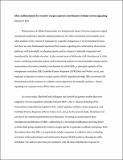| dc.contributor.author | Kim, Dennis H. | |
| dc.date.accessioned | 2018-07-27T20:09:43Z | |
| dc.date.available | 2018-07-27T20:09:43Z | |
| dc.date.issued | 2016-08 | |
| dc.identifier.issn | 1097-2765 | |
| dc.identifier.issn | 1097-4164 | |
| dc.identifier.uri | http://hdl.handle.net/1721.1/117179 | |
| dc.description.abstract | Maintenance of cellular homeostasis is a fundamental aspect of stress-responsive signal transduction pathways. Specific signaling pathways are often considered, and certainly most often studied, in the context of responses to a specific endogenous or environmental stressor, but there are also fundamental questions that remain regarding how information about stress pathways with potentially overlapping inputs and/or outputs is optimally integrated and transduced by the cellular circuitry. In the current issue of Molecular Cell, Hourihan et al. (2016), combining molecular genetic and biochemical analysis in Caenorhabditis elegans and in mammalian cell systems, identify a mechanism by which IRE1, a principal regulator of the endoplasmic reticulum (ER) Unfolded Protein Response (UPR) (Walter and Ron, 2011), also regulates a response to reactive oxygen species (ROS). Signaling through IRE1 to promote ER homeostasis and the response to oxidative stress appears to be mutually exclusive—that is, signaling one response turns off the other, and vice versa. | en_US |
| dc.language.iso | en_US | |
| dc.publisher | Elsevier | en_US |
| dc.relation.isversionof | https://doi.org/10.1016/j.molcel.2016.08.003 | en_US |
| dc.rights | Creative Commons Attribution-NonCommercial-NoDerivs License | en_US |
| dc.rights.uri | http://creativecommons.org/licenses/by-nc-nd/4.0/ | en_US |
| dc.source | Prof. Kim via Courtney Crummett | en_US |
| dc.title | IRE1 sulfenylation by reactive oxygen species coordinates cellular stress signaling | en_US |
| dc.type | Article | en_US |
| dc.identifier.citation | Kim, Dennis H. “IRE1 Sulfenylation by Reactive Oxygen Species Coordinates Cellular Stress Signaling.” Molecular Cell, vol. 63, no. 4, Aug. 2016, pp. 541–42. | en_US |
| dc.contributor.department | Massachusetts Institute of Technology. Department of Biology | en_US |
| dc.contributor.approver | Kim, Dennis | en_US |
| dc.contributor.mitauthor | Kim, Dennis H | |
| dc.relation.journal | Molecular Cell | en_US |
| dc.eprint.version | Author's final manuscript | en_US |
| dc.type.uri | http://purl.org/eprint/type/JournalArticle | en_US |
| eprint.status | http://purl.org/eprint/status/PeerReviewed | en_US |
| dspace.orderedauthors | Kim, Dennis H. | en_US |
| dspace.embargo.terms | N | en_US |
| dc.identifier.orcid | https://orcid.org/0000-0002-4109-5152 | |
| mit.license | PUBLISHER_CC | en_US |
